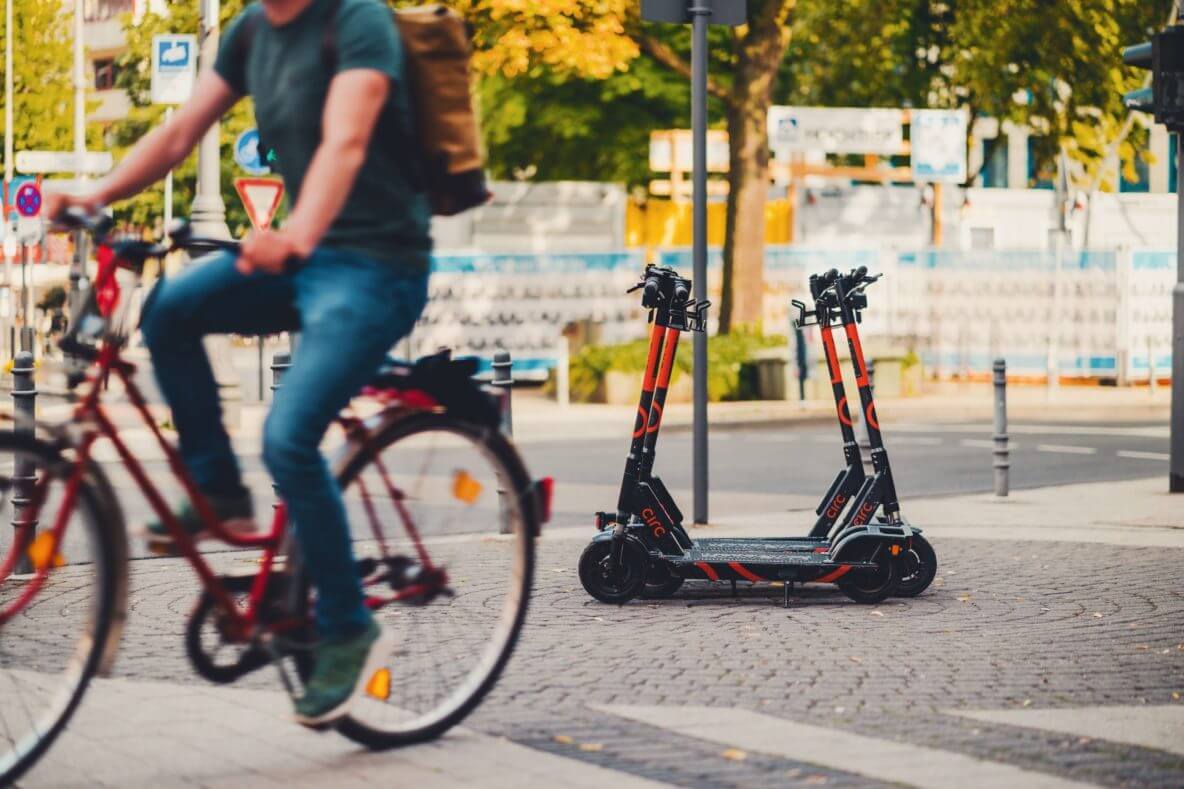
Table of contents
E-scooters: what good are they really?
In the summer of 2019, they popped up like mushrooms in Germany overnight: e-scooters. Since then, there have been divided opinions: Some think that e-scooters are sustainable and relieve traffic; Others, on the other hand, are annoyed and see the scooters as more of a danger on the already busy cycle paths. So what is really the sustainability of e-scooters?
The basic facts
E-scooters, also known as e-scooters or e-scooters, have been on Germany's streets since June 15th. Yes, they have been hard to miss since then. But Germany is not a pioneer; The scooters have been available in many European cities since the beginning of 2018.
The 20 km/h e-scooters can be ridden on cycle paths from the age of 14. There is no requirement to wear a helmet. The e-scooters must be insured. And that’s it for the basic rules.
The arguments
If you ask around among your friends, the most common arguments in favor of using e-scooters are the following:
- It's fun!
- These things are practical; You can get anywhere quickly and don't have to get your bike out of the basement.
- You can start from wherever you are.
- E-scooters are a more sustainable alternative to driving.
- You feel free and flexible.
There are also some arguments against e-scooters:
- They pollute the streetscape. It's annoying that they're standing around everywhere; hardly anyone puts them down properly.
- These things are unsafe and therefore pose a danger.
- There is not enough space on the bike paths.
- We don't yet know whether they really represent an ecological alternative to the transport system...
But what's the truth about the arguments?
Flexibility and freedom
There is hardly anything wrong with this argument. If you want to get from A to B quickly, you can grab an e-scooter and get to your destination in no time - at least faster than on foot. The scooters aren't really that expensive either: if you want to ride one of these, you pay 1 euro. Depending on the city, 15-30 cents are added per minute of travel.
Cityscape
I have to say that the e-scooters sometimes annoy me. Scooters that were parked in the middle of the sidewalk or thrown into the nearest ditch - that's definitely not the point of the matter. It would certainly be good if the e-scooter system could be expanded even further; if there were more permanent parking spaces and the roads were better developed or optimized for driving such a scooter. Maybe for many of us the whole thing is just a matter of getting used to it; Sometimes we just have a hard time with new things and therefore initially make them look bad.
Security
Unfortunately, there have already been a number of deaths across Europe of people who have died in accidents with e-scooters. Of course, the fact that there is no obligation to wear a helmet doesn't make things any safer. Riding two people on an electric stand-up scooter also poses a danger. For these reasons, France recently tightened the rules for riding e-scooters. Those who use their cell phones while driving or drive as a couple now have to expect a fine of 35 euros. France now has a speed limit of 25 km/h; However, e-scooters can still be driven on sidewalks (albeit with stricter rules).
In Germany, these rules are stricter from the start (the maximum speed is 20 km/h; driving is only allowed on cycle paths), but there are also fines here: 20 euros if you obstruct other road users and a 10 euro fine for two-person driving. You can view the complete catalog of fines here view. The problem here is always that the violations have to be noticed and recorded...
There are currently four major providers in Germany: Lime and BIRD from the USA, voi from Sweden, circ from Luxembourg and TIER, a Berlin startup. Next spring you can expect a few more providers to be added.
However, a reduction in the number of providers would be better for security. Because then the number of e-scooters themselves would also decrease.

Sustainability of e-scooters
Now let's get to the really exciting point: What is the sustainability of e-scooters?
First of all, e-scooters run electrically and are lighter and smaller than cars. This means they also produce less CO2. However, it is not yet clear how much this will actually bring in the end. There are no official studies on this yet.
Initial assessments and comparisons with e-bikes show that an e-scooter produces around 5 g of CO2 when charging the battery to be able to travel 1 km. A car burns around 120 g of CO2 over the same distance. The pure numbers speak for the e-scooter. But is that enough to call it sustainable?
At the moment, scooters just mean more vehicles on the roads. It is questionable whether e-scooters will really replace car journeys. It seems that pedestrians in particular use scooters to cover longer distances. This means that they do not complement local public transport, but rather hinder it. Instead of sitting on the bus or train, some people now ride e-scooters. And I doubt whether that is really sustainable.
In order for e-scooters to really contribute to greater sustainability and a better climate footprint in the future, three things would have to change:
1. Usage behavior:
E-scooters should replace car traffic. For example, they can be used great for the “last mile”; i.e. for the journey from home to the bus or train. In addition, electric stand-up scooters are only available in large cities where local public transport is already well developed. They don't exist in rural areas, even though they would be good alternatives to cars there. The reason why there are no scooters in rural areas is that the business only becomes profitable for providers with around 100,000 inhabitants.
2. The battery:
The batteries in the scooters are permanently installed. Therefore, the e-scooters have to be collected and charged by employees in the evening. They are often picked up by diesel or petrol sprinters, which really doesn't help the ecological balance. Some providers are now working on e-scooters that will be equipped with replaceable batteries and will no longer need to be moved. E-cargo bikes then replace the batteries directly on site. That would improve the situation significantly.
3. Longevity:
The e-scooters have to last longer to have a good climate balance. According to the manufacturer, they currently last about a year. Unfortunately, many people don't handle e-scooters as carefully as they would their own scooter. In Marseille, the scooters end up in the port, in Greece somewhere in nature and in Paris, incorrectly parked e-scooters are disposed of as bulky waste...
After all, e-scooters are built in such a way that individual parts can be replaced, which can significantly increase their service life.
So we can say that e-scooters are not really doing anything for the climate at the moment. They are in themselves more climate-friendly than cars, but for that to really count, they have to replace car journeys. It is not yet clear whether this is a hype that creates a lot of e-waste or a truly profitable market. That remains to be seen.
What do you think about e-scooters and their sustainability?
If you would like to find out more about the topics of sustainability, mindfulness or healthy eating, take a look here over.





























Leave a comment
This site is protected by hCaptcha and the hCaptcha Privacy Policy and Terms of Service apply.